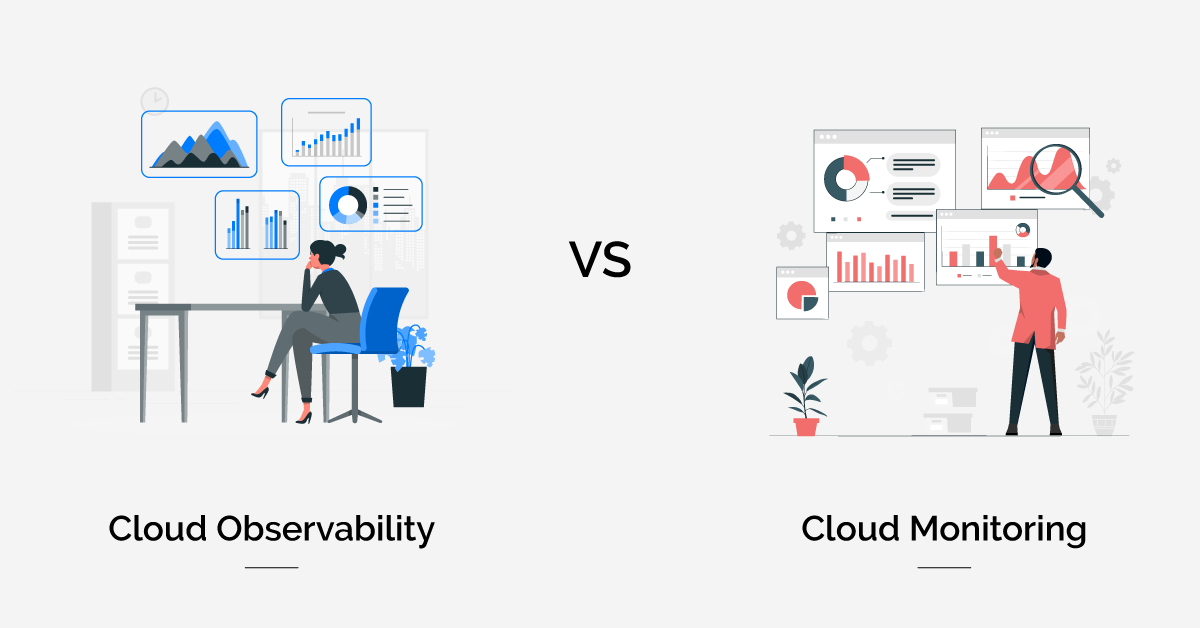
Observability vs. Monitoring: Choosing the Right Approach for Your Business
When application issues arise, they impact customers and business operations. Teams rely on cloud observability and cloud monitoring to quickly identify and resolve these issues.
Monitoring and observability are two approaches for identifying the root causes of problems. Monitoring alerts you when something goes wrong, whereas observability tells you about the ‘what,’ ‘why,’ behind the issues, and ‘how’ to resolve them. Let’s explore their functionalities and roles in modern software development to know which tool wins this cloud observability vs. cloud monitoring battle.
What is cloud observability?
Observability is the capacity to comprehend the inner workings of a complex system by scrutinizing its external results. When a system demonstrates observability, users can pinpoint the root cause of a performance problem by analyzing the data it produces without needing extra testing or coding.
This concept came from control theory, an engineering principle that signifies the capability to diagnose internal issues from the outside. For example, automotive diagnostic systems provide observability for mechanics, allowing them to understand why a car fails to start without taking it apart.
What is cloud monitoring?
Monitoring in DevOps involves assessing a system’s health by collecting and analyzing data from IT systems using predefined metrics and logs. It helps measure the application’s health by setting alerts for critical thresholds, like 100% disk usage, to prevent downtime. Additionally, monitoring provides valuable insights into long-term trends and usage patterns, not just mere functioning.
While monitoring is effective for detecting known failures and system performance, it has limitations. To be effective, you must know which metrics and logs to track. Otherwise, you can miss critical production failures and other problems.
Cloud observability vs. Cloud monitoring: How it works
Cloud observability vs. Cloud monitoring: The difference lies in detecting expected and potential issues. At its core, monitoring is reactive, while observability takes a proactive approach. Both rely on the same type of telemetry data, often called the three pillars of observability.
These three pillars of observability include:
- Logs: Records of what’s happening within your software.
- Metrics: Quantitative assessments of application performance and resource utilization.
- Traces: Tracking operations as they move through a system, moving from one node to another.
During monitoring, teams use this telemetry data to define metrics internally, create predefined dashboards, and set up notifications. Moreover, they identify and document dependencies, revealing how each component of an application relies on other components, applications, and IT resources.
Observability tools and automation
Observability and monitoring tools delve beyond tracking internal states and addressing problems. These platforms are crucial to quickly solving problems, streamlining pipelines, and enabling increased focus on core business activities and innovation.
Let’s delve deeper into various types of tools and approaches to observability and monitoring:
Observability Platforms: These platforms enable teams to seamlessly integrate monitoring, logging, and tracing across their IT environment, offering a comprehensive view of the system’s status, even in distributed systems. Some platforms may include user experience and business context to provide a more comprehensive performance assessment. Depending on the platform, they are designed to visualize both on-premises systems and complex multi-cloud environments.
Open Source: Open-source data observability tools, such as OpenTelemetry, help teams in monitoring and debugging applications, gathering log and metric data, and performing tracing. While these tools offer certain observability functions, they may only cover some aspects and are often combined with other tools.
Automation: Observability automation extends existing automation within the CI/CD pipeline, further freeing DevOps teams to focus on core responsibilities. For example, IBM Instana Observability offers advanced automation features that improve the CI/CD pipeline. It achieves this by automating the discovery of applications, infrastructure, and services, eliminating the requirement for developers to manually code application and service links with each update. Additionally, leveraging AI-assisted troubleshooting, IBM Instana vs dynatrace can predict incidents and automate remediation. This fully automated application performance management system meticulously monitors each service, traces every request, and profiles every strategy.
Observability and IBM Instana
IBM Instana provides a comprehensive automated enterprise observability platform that delivers the context for informed decision-making and ensures optimal application performance. For instance, IBM Instana offers the following features and advantages:
- Automation: Gain complete observability within dynamic environments through automated discovery. This capability enables tracking every request, recording all changes, and providing one-second granularity metrics.
- Context: Gain insight into all application interdependencies to detect issues and determine impact. IBM Instana transforms raw data into meaningful information, offering an interactive model of real-time relationships among all entities.
- Intelligent Action: Take proactive measures to detect and resolve issues while understanding their contributing factors. Analyze every user request from various angles to quickly identify and address bottlenecks.
IBM Instana Observability Use Cases
IBM Instana offers various use cases for observability across multiple industries and IT environments:
- Application Performance Monitoring (APM): Instana offers immediate, up-to-the-minute insights into your applications’ performance metrics, encompassing response times, error rates, and resource consumption. APM helps identify bottlenecks, latency issues, and other performance problems to ensure a seamless user experience.
- Microservices Monitoring: In microservices architectures, tracking the health and performance of individual services is crucial. IBM Instana auto-discovers and monitors all microservices, making identifying and resolving issues within your ecosystem easy.
- Container Orchestration: Instana supports popular container orchestration platforms like Kubernetes and Docker Swarm. It allows you to monitor containerized applications and services, ensuring they run smoothly and scale efficiently.
- Infrastructure Monitoring: Beyond application performance, Instana also monitors infrastructure components such as servers, virtual machines, and cloud resources. It helps you gain visibility into the health of your entire IT stack.
- End-User Monitoring: Instana offers user-centric monitoring capabilities to track user interactions with your applications. This enables you to understand the user experience and address issues affecting end-users.
- AI-Powered Insights: Leveraging artificial intelligence, Instana can predict incidents and suggest remediation steps. This proactive approach to observability helps prevent downtime and performance degradation.
- Multi-Cloud and Hybrid Cloud Monitoring: If your organization operates across multiple cloud providers or maintains a hybrid cloud infrastructure, Instana provides a unified view of your entire environment, helping you manage complexity effectively.
- Compliance and Security: Instana offers security and compliance monitoring to ensure your applications and infrastructure meet regulatory requirements and security standards.
- These use cases demonstrate how IBM Instana observability can benefit organizations across various industries, improving application performance, reducing downtime, and enabling proactive problem resolution.
Conclusion
The decision between observability and monitoring is more than a one-size-fits-all choice for businesses. It helps you analyze your organization’s needs, goals, and infrastructure. Observability offers proactive, in-depth insights for long-term optimization, while monitoring excels at immediate issue detection and response. To make the right choice, consider the strengths of each approach and, in many cases, opt for a balanced combination that aligns with your business objectives. This strategic approach ensures that you are well-equipped to maintain your IT systems’ health and performance effectively.


More on Technology
Innominds and Qualcomm Collaborate to Drive Enterprise Digital Transformation with High-Compute Edge AI Platform
-
Team Eela



